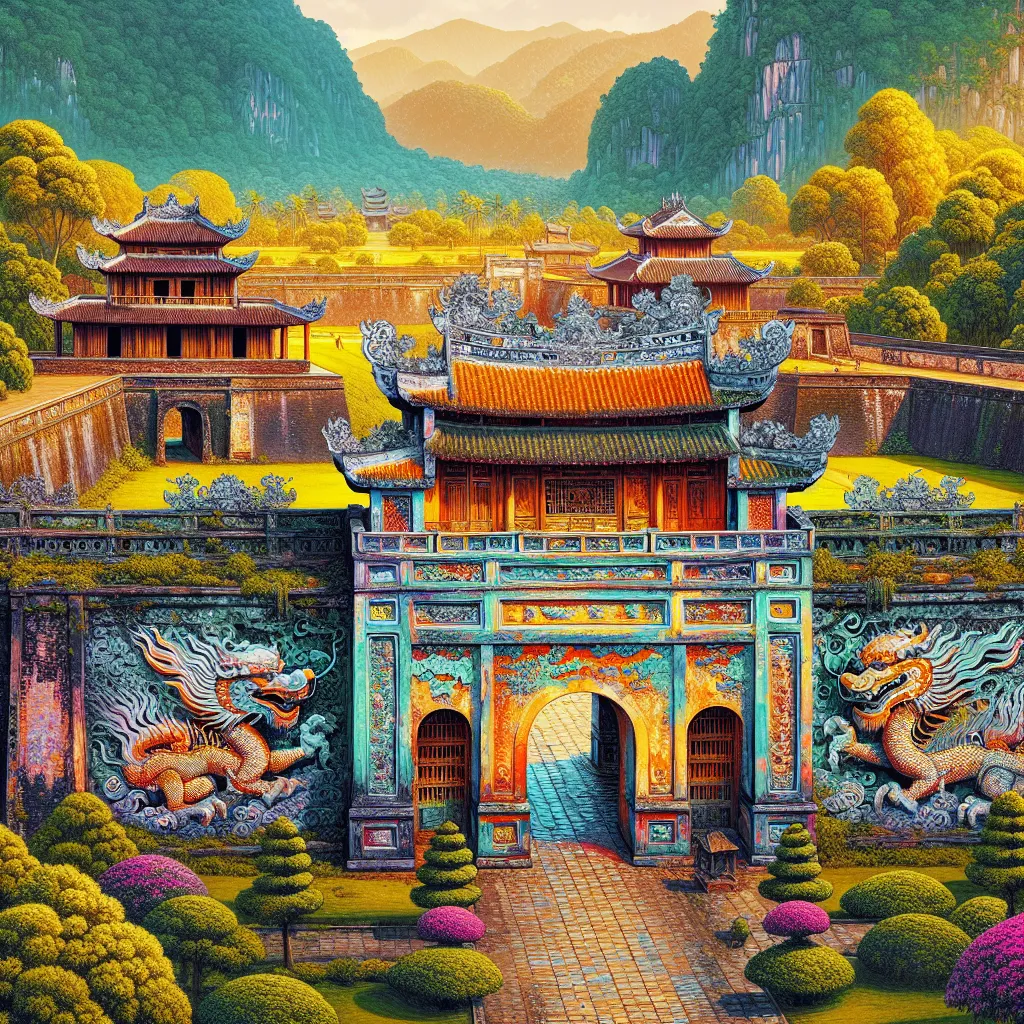As an IELTS examiner and experienced English teacher, I’m excited to help you excel in describing a famous historical site for your IELTS Speaking test. This topic is quite common and likely to appear in future exams. Let’s explore how to tackle this subject effectively and boost your score.
Part 1: Introduction and Interview
In Part 1, the examiner may ask some general questions about historical sites. Here are a few examples:
- Are there many historical sites in your country?
- Do you like visiting historical sites? Why or why not?
- What’s the most famous historical site in your country?
Let’s look at a sample answer for the third question:
Sample Answer (Band 8-9):
“The most renowned historical site in Vietnam is undoubtedly Ha Long Bay. It’s a UNESCO World Heritage Site located in the northeast of the country, famous for its breathtaking limestone karsts and islets. The bay has been recognized internationally for its exceptional natural beauty and geological significance. It’s not only a popular tourist destination but also a source of great national pride for Vietnamese people.”
Part 2: Long Turn (Cue Card)
Now, let’s move on to Part 2, where you’ll be given a cue card to describe a famous historical site. Here’s a sample cue card:
Describe a famous historical site in your country
You should say:
- Where it is located
- What it looks like
- What people can do there
- And explain why it is famous
Sample Answer (Band 8-9):
“I’d like to talk about the Imperial City of Hue, a magnificent historical complex located in central Vietnam. This UNESCO World Heritage site was once the political and cultural epicenter of the country during the Nguyen Dynasty.
The Imperial City is situated in the heart of Hue, straddling the picturesque Perfume River. It’s an awe-inspiring sight, with its massive stone walls stretching over 2 kilometers in circumference. The most striking feature is undoubtedly the Meridian Gate, a colossal structure adorned with intricate dragon motifs and vibrant colors.
Visitors to the Imperial City can immerse themselves in Vietnam’s rich history. They can explore the vast courtyards, ornate temples, and beautifully preserved palaces. Many tourists enjoy donning traditional Vietnamese costumes for photos, participating in cultural performances, or simply strolling through the meticulously manicured gardens.
The Imperial City of Hue is famous for several reasons. Firstly, it exemplifies the pinnacle of Vietnamese feudal architecture. The harmonious blend of natural landscapes and man-made structures showcases the ingenuity of ancient Vietnamese designers. Secondly, it played a crucial role in Vietnam’s history, serving as the seat of power for the Nguyen Dynasty, Vietnam’s last ruling family. Lastly, despite suffering significant damage during the Vietnam War, the site has undergone extensive restoration, symbolizing the resilience and determination of the Vietnamese people to preserve their cultural heritage.”
 Imperial City of Hue
Imperial City of Hue
Additional Questions (Bullet Points):
- What’s the best time to visit this historical site?
- Are there any legends or myths associated with this place?
Sample Answers (Band 8-9):
-
“The optimal time to visit the Imperial City of Hue is during the spring months, from February to April. During this period, the weather is pleasantly mild, with less rainfall compared to other seasons. Moreover, this timeframe often coincides with the Hue Festival, a biennial cultural event that showcases traditional music, dance, and crafts. Visitors can experience the site at its most vibrant, with numerous performances and activities bringing the ancient capital to life.”
-
“Indeed, there are several intriguing legends associated with the Imperial City. One of the most famous relates to the construction of the Perfume River, which flows through Hue. According to local folklore, the river was created by the tears of a dragon who fell in love with a fairy but was forced to return to the sea. This legend adds a layer of mystique to the site and reflects the deep connection between Vietnamese culture and nature. Another myth suggests that the city’s location was chosen by geomancers who believed it to be a place where dragon and tiger energies converged, making it an auspicious site for the imperial capital.”
Part 3: Two-way Discussion
In Part 3, the examiner will ask more abstract questions related to historical sites. Here are some potential questions and sample answers:
Q: How important is it for a country to preserve its historical sites?
Sample Answer (Band 8-9):
“Preserving historical sites is absolutely crucial for any nation. These sites serve as tangible links to our past, allowing us to better understand our cultural heritage and national identity. They provide invaluable insights into the architectural, artistic, and technological achievements of our ancestors, which can inspire and educate future generations.
Moreover, historical sites often play a significant role in a country’s tourism industry, contributing to economic growth and creating job opportunities. They can also foster a sense of pride among citizens and promote cultural exchange with international visitors.
However, preservation efforts often face challenges, such as limited funding, urban development pressures, and environmental factors. It’s crucial for governments to strike a balance between progress and preservation, perhaps by implementing sustainable tourism practices and integrating historical sites into modern urban planning.”
Q: Do you think technology can help in preserving historical sites? How?
Sample Answer (Band 8-9):
“Absolutely, technology plays an increasingly vital role in preserving historical sites. One of the most groundbreaking applications is the use of 3D scanning and modeling. These technologies allow for the creation of highly detailed digital replicas of historical structures, which can be used for documentation, restoration planning, and even virtual tourism.
Augmented reality (AR) is another exciting development. It can enhance visitors’ experiences by overlaying historical information or recreating damaged parts of a site virtually. This not only makes education more engaging but also reduces physical wear and tear on the actual site.
Furthermore, advanced monitoring systems using sensors and drones can help detect structural issues or environmental threats early on, allowing for timely interventions. Artificial intelligence can assist in analyzing vast amounts of historical data, potentially uncovering new insights about a site’s history or construction.
However, it’s important to note that while technology is a powerful tool, it should complement rather than replace traditional preservation methods. The human element – the expertise of historians, archaeologists, and conservationists – remains indispensable in interpreting and preserving our cultural heritage.”
Key Vocabulary and Phrases
To elevate your IELTS Speaking score, incorporate these advanced words and phrases:
-
UNESCO World Heritage Site /juːˈneskəʊ wɜːld ˈherɪtɪdʒ saɪt/ (noun phrase): A place listed by UNESCO as being of special cultural or physical significance.
Example: “Angkor Wat is a UNESCO World Heritage Site in Cambodia.” -
Cultural heritage /ˈkʌltʃərəl ˈherɪtɪdʒ/ (noun phrase): The legacy of physical artifacts and intangible attributes of a group or society.
Example: “The Colosseum in Rome is an important part of Italy’s cultural heritage.” -
Architectural marvel /ˌɑːkɪˈtektʃərəl ˈmɑːvl/ (noun phrase): A building or structure that inspires wonder due to its design or construction.
Example: “The Taj Mahal is widely regarded as an architectural marvel.” -
To immerse oneself /tə ɪˈmɜːs wʌnˈself/ (verb phrase): To involve oneself deeply in a particular activity or interest.
Example: “Visitors can immerse themselves in ancient Egyptian culture at the pyramids.” -
Restoration /ˌrestəˈreɪʃn/ (noun): The process of returning something to its original condition.
Example: “The restoration of the Sistine Chapel took over a decade to complete.”
Examiner’s Advice
To excel in describing historical sites in your IELTS Speaking test:
- Research thoroughly: Familiarize yourself with key historical sites in your country and globally.
- Practice describing visually: Work on vividly depicting architectural features and landscapes.
- Develop personal opinions: Be ready to discuss the importance and impact of historical sites.
- Use varied vocabulary: Incorporate advanced terms related to history, architecture, and culture.
- Stay updated: Be aware of current preservation efforts and technological advancements in this field.
Remember, the key to a high score is not just knowledge, but the ability to articulate your thoughts clearly and engage in a meaningful discussion about historical sites.


